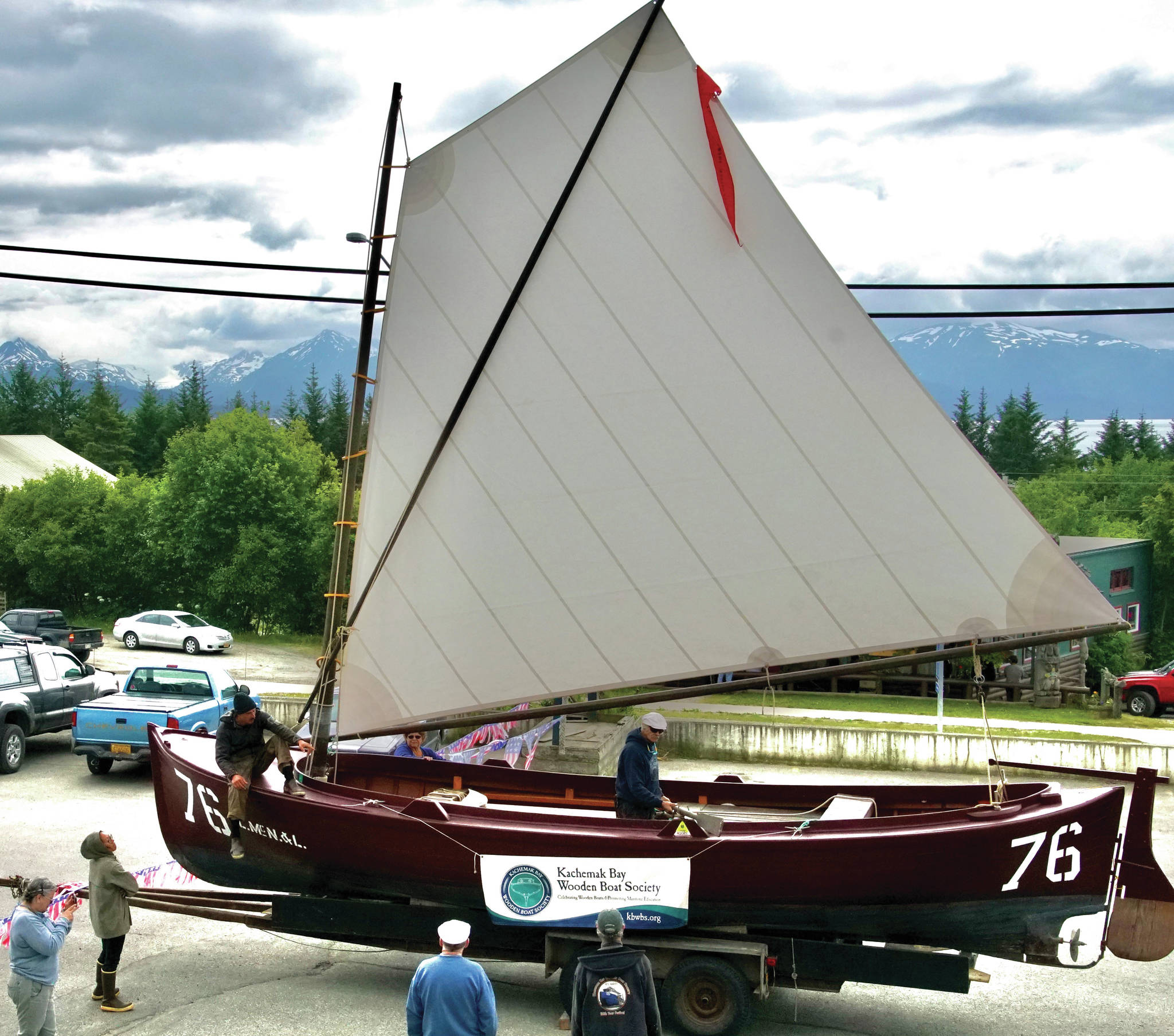Like a lot of things in the past year and a half, the historic “Sailing Back To the Bay” event had to be postponed. Originally scheduled to take place during last year’s Fourth of July celebrations, it was postponed again this year due to the COVID-19 pandemic. The launch of No. 76, a 29-foot restored Libby, McNeil and Libby double-ender sailboat once used for commercial fishing in Bristol Bay, and its journey in the decades-old wake of fishing boats traveling from Homer to the bay have been rescheduled for 2022.
The delay was fortuitous, allowing time for Frank Schattauer Sails of Seattle to complete a new sail that was hoisted on the vessel’s single mast by Dave Seaman and friends on July 3, in the NOMAR parking lot. Seaman oversaw the restoration work and will captain No. 76 when it makes its voyage a year from now. The delay also allowed time for Seaman to research the vessel’s past.
“It was converted from a sailboat to a powerboat in 1951 and 1952, towed from Libbyville to Homer in 1979, and reconverted to a sailboat on the Homer Spit in the 1980s,” said Seaman. “Under the Libby orange paint on the exterior were layers of red paint, typical of Libbyville sailboats from the day.”
Seaman also found “LXXVI” stamped on the mast, hence the freshly painted “76” on the vessel’s hull.
The 29-foot-long and 9-foot-wide beam wooden construction is about more than just this one boat, however.
“This is all about the positive aspects and sustainability of the fishing life, business and culture,” said Seaman, referring to a fishery that began in 1884 and continues today. Bristol Bay’s first cannery was owned by Arctic Packing Company, constructed near Dillingham, and, in its first year, produced 400 cases of canned salmon. Other canneries followed suit, drawing fishermen and workers from the surrounding area, as well as Scandinavia, China, Japan, the Philippines, Mexico, Italy, England and Ireland.
During territorial days, Alaska’s fisheries were managed by the federal government. Bristol Bay fishing could be done only from sailboats. Vessels used in the treacherous Columbia River provided a double-ended template, named for the pointed construction at both bow and stern. Canneries owned the vessels, controlled who fished them and would tow the boats with the fishermen aboard to the fishing grounds.
“(The vessels) had keels and ribs of white oak, planking of Port Orford, Oregon’s yellow cedar, and were sprit-rigged with a wing-shaped sail,” said Seaman. “Belying their sweet lines, these boats were built for work.”
The same can be said for the fishermen. Six days a week, round the clock, without benefit of engines or radios, they navigated the Bay’s dangerous sandbars and life-threatening tides. The boats’ open-hull design left them exposed to wind, rain and sun. The men were there for work, not fun. “Iron men in wooden boats,” the saying went.
Bristol Bay finally legalized motorized boats in 1951. A year later, powerboats outnumbered sailboats 895 to 223. By 1954, the number of sailboats plying the Bay had shrunk to 15.
Organizing “Back To the Bay” with Seaman are Tim Troll, executive director of Bristol Bay Heritage Land Trust, and Kate Mitchell, a founding member of Homer Marine Trades Association and of the family-owned NOMAR, a well-known designer and supplier of outdoor wear and products for commercial fishermen.
“There were early Homer-area homesteaders that fished Bristol Bay, and starting the journey in Homer gives people an opportunity to share in the history and watch the journey,” said Mitchell. Homer’s marine trades have kept that decades-long connection strong. “Lots of Homer fishermen bring their boats back to Homer to get their upgrades and work done, and many boats are built in Homer for the Alaska fisheries.”
For Troll, “the idea of seeing one of these sailboats in Bristol Bay after 50, 60 years just seems right. And obviously we’re honoring the ‘iron men of Bristol Bay,’ the forefathers of a fishery that is still going on today.”
The 2022 sailing of No. 76, with Seaman at the helm, will begin in Homer and continue across Cook Inlet to Williamsport. There it will make the historic 26-mile portage to Iliamna Lake with the help of Ray Williams, and charged at the 1938 portaging price of $10 per linear foot. Traveling the length of the lake, No. 76 will pay visits to communities along the way, navigate the Kvichak River and finally arrive in Naknek. The 200-mile voyage is estimated to take two weeks.
Helping fund this tribute to Alaska fisheries are NOMAR’s sale of Ray Troll T-shirts, sweatshirts and traditional white fishermen’s caps bearing the event logo and the sale of Tim Troll’s book “Sailing For Salmon, the Early Years of Commercial Fishing in Alaska’s Bristol Bay 1884-1951,” also available at NOMAR.
“The fact that NOMAR chose the Bristol Bay double-ender as our logo made this an easy thing to be part of,” said Mitchell. “This is a celebration of Alaska’s maritime history, its historic clean waters and healthy fisheries.”
Financial support and volunteer hours also are being provided by the Kachemak Bay Wooden Boat Society.
“Every time I look at one of those sailboats, I just feel like I’ve not done much compared to what those guys did,” said Homer boat-builder Jim Lunny. “It’s going to be quite an adventure and not going to be an easy thing in a slow sailboat, going over there. I really admire (Seaman) for doing it.”
In-kind and financial support of the project also is coming from Cook Inletkeeper, Bristol Bay Heritage Land Trust, Bristol Bay Borough Chamber of Commerce, the NN Cannery History Project, Alaska Alpine Adventures, and Trident Seafoods, among others. Video documentation is being done by Mark Brinster.
Donations can be made via Facebook, on the Bristol Bay Heritage Land Trust website at bristolbaylandtrust.org/sailing/, or by mailing checks to Bristol Bay Heritage Land Trust, a 501(c)3 organization, P.O. Box 1388, Dillingham, Alaska 99576-1388.
For more information, visit facebook.com/forsalmonsake/videos.


